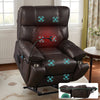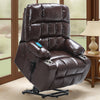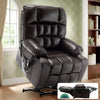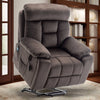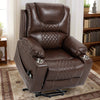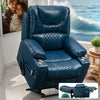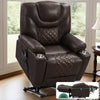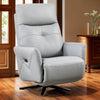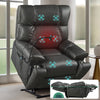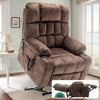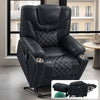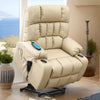Understanding the Chair Lift: Types and Functions
The Basics of Chair Lift Mechanisms
Chair lifts are essential for helping elderly people move around their homes. They work by using a motor to lift and lower a seat. This allows seniors to sit and move up or down stairs easily.
Most chair lifts have a track that attaches to the stairs. The chair slides along this track. It uses a battery or plugs into the wall for power. The controls are simple, usually just buttons to go up or down.
Chair lifts can be straight or curved. Straight ones work for simple staircases. Curved lifts are for stairs with turns. Some models can even go around corners or to different floors.
Safety is a key part of chair lifts. They have sensors to stop if something is in the way. Seat belts keep users secure. Many also have backup batteries in case of power outages.
Different Types of Chair Lifts Available in the Market
There are several types of chair lifts to choose from. Each has its own benefits for different needs.
- Straight Stairlift: This is the most common type. It's best for straight staircases without turns.
- Curved Stairlift: These are custom-made for stairs with curves or landings.
- Outdoor Stairlift: Made to withstand weather, these work on outdoor steps.
- Standing Stairlift: For those who have trouble sitting, this lets users stand and lean.
- Wheelchair Platform Lift: This moves the whole wheelchair up and down stairs.
- Ceiling Track Lift: These attach to the ceiling and help move between rooms.
- Through-Floor Lift: This is like a small elevator that goes between floors.
When choosing, think about the user's needs and the home's layout. Some lifts can be moved or shared between homes. Others are permanent fixtures.
Evaluating the Best Chair Lifts for Elderly Patients
Key Features to Look for in Elderly Chair Lifts
When picking a chair lift for an elderly person, certain features are crucial:
- Safety: Look for seatbelts, obstacle sensors, and smooth starts and stops.
- Comfort: The seat should be padded and have good back support.
- Easy Controls: Large, clearly marked buttons are best. Some have remote controls too.
- Swivel Seat: This makes getting on and off the lift safer, especially at the top of stairs.
- Foldability: The seat and footrest should fold up to save space when not in use.
- Battery Backup: This ensures the lift works even during power outages.
- Weight Capacity: Make sure it can safely hold the user's weight.
- Quiet Operation: A noisy lift can be disturbing, especially in a quiet home.
- Footrest Sensor: This stops the lift if anything is under the footrest.
- Adjustable Seat Height: This helps users sit down and stand up more easily.
Remember, the best features depend on the user's specific needs and abilities.
How to Determine the Right Size and Style for Your Elderly Loved One
Choosing the right size and style of chair lift is crucial for comfort and safety:
- Measure the Staircase: Get the length, width, and any turns or landings.
- Consider the User's Size: The seat should be wide enough and support their weight.
- Assess Mobility: How easily can they transfer to and from the chair?
- Look at Home Decor: Choose a style that fits with the home's look.
- Think About Future Needs: Will their condition change over time?
- Check Doorways and Landings: Make sure there's enough space at the top and bottom.
- Consider Other Users: Will others need to use the stairs when the lift is parked?
- Evaluate Arm Strength: Can they easily operate the controls?
- Think About Maintenance: Some styles are easier to clean and maintain.
- Consider Portability: Will they need to move the lift in the future?
It's often helpful to consult with a healthcare provider or occupational therapist. They can give expert advice on the best fit for your loved one's needs.
Navigating Regulations and Standards in the United States
Safety Regulations for Chair Lifts in Elderly Care Facilities
In the United States, chair lifts in elderly care facilities must meet strict safety rules:
- ASME A18.1: This is the main safety code for platform lifts and stairway chairlifts.
- NFPA 101: The Life Safety Code sets rules for safe building design and fire protection.
- State-Specific Codes: Some states have additional rules for chair lifts.
- Regular Inspections: Most states require yearly safety checks by certified inspectors.
- Emergency Power: Facilities must have a plan for power outages to keep lifts working.
- User Training: Staff must be trained on how to use and maintain the lifts safely.
- Weight Limits: Lifts must clearly show and never exceed their weight capacities.
- Maintenance Records: Facilities must keep detailed records of all lift maintenance.
- Emergency Stop: All lifts must have an easy-to-reach emergency stop button.
- Call Systems: Many facilities require a way for users to call for help if needed.
These rules help ensure that chair lifts are safe for elderly residents to use every day.
Complying with Americans with Disabilities Act (ADA) for Accessibility
The Americans with Disabilities Act (ADA) sets rules for making buildings accessible:
- Clear Floor Space: There must be enough room to approach and use the lift.
- Controls: Buttons and switches must be easy to reach and use.
- Signage: Clear signs must show how to use the lift and its weight limit.
- Edge Protection: Lifts must have guards to prevent wheels from rolling off.
- Door and Gate Design: Any doors or gates must be easy to open and close.
- Platform Size: For wheelchair lifts, the platform must be big enough for most chairs.
- Ramp Slopes: Any ramps leading to the lift must not be too steep.
- Call Buttons: These must be placed where someone in a wheelchair can reach them.
- Lighting: The lift area must be well-lit for safety.
- Emergency Communication: There must be a way to call for help in an emergency.
These rules apply to public buildings and many businesses. They help ensure that people with disabilities can access buildings safely and independently.








